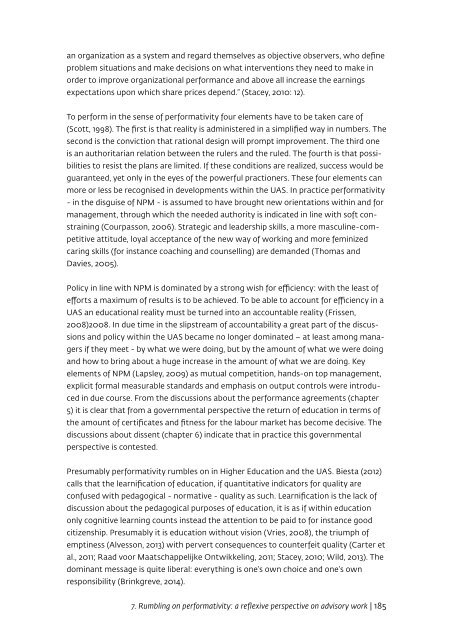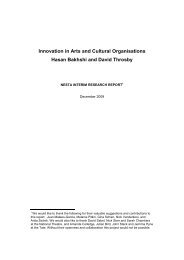Rumbling on performativity_Frits Simon
Rumbling on performativity_Frits Simon
Rumbling on performativity_Frits Simon
Create successful ePaper yourself
Turn your PDF publications into a flip-book with our unique Google optimized e-Paper software.
an organizati<strong>on</strong> as a system and regard themselves as objective observers, who define<br />
problem situati<strong>on</strong>s and make decisi<strong>on</strong>s <strong>on</strong> what interventi<strong>on</strong>s they need to make in<br />
order to improve organizati<strong>on</strong>al performance and above all increase the earnings<br />
expectati<strong>on</strong>s up<strong>on</strong> which share prices depend.” (Stacey, 2010: 12).<br />
To perform in the sense of <strong>performativity</strong> four elements have to be taken care of<br />
(Scott, 1998). The first is that reality is administered in a simplified way in numbers. The<br />
sec<strong>on</strong>d is the c<strong>on</strong>victi<strong>on</strong> that rati<strong>on</strong>al design will prompt improvement. The third <strong>on</strong>e<br />
is an authoritarian relati<strong>on</strong> between the rulers and the ruled. The fourth is that possibilities<br />
to resist the plans are limited. If these c<strong>on</strong>diti<strong>on</strong>s are realized, success would be<br />
guaranteed, yet <strong>on</strong>ly in the eyes of the powerful practi<strong>on</strong>ers. These four elements can<br />
more or less be recognised in developments within the UAS. In practice <strong>performativity</strong><br />
- in the disguise of NPM - is assumed to have brought new orientati<strong>on</strong>s within and for<br />
management, through which the needed authority is indicated in line with soft c<strong>on</strong>straining<br />
(Courpass<strong>on</strong>, 2006). Strategic and leadership skills, a more masculine-competitive<br />
attitude, loyal acceptance of the new way of working and more feminized<br />
caring skills (for instance coaching and counselling) are demanded (Thomas and<br />
Davies, 2005).<br />
Policy in line with NPM is dominated by a str<strong>on</strong>g wish for efficiency: with the least of<br />
efforts a maximum of results is to be achieved. To be able to account for efficiency in a<br />
UAS an educati<strong>on</strong>al reality must be turned into an accountable reality (Frissen,<br />
2008)2008. In due time in the slipstream of accountability a great part of the discussi<strong>on</strong>s<br />
and policy within the UAS became no l<strong>on</strong>ger dominated – at least am<strong>on</strong>g managers<br />
if they meet - by what we were doing, but by the amount of what we were doing<br />
and how to bring about a huge increase in the amount of what we are doing. Key<br />
elements of NPM (Lapsley, 2009) as mutual competiti<strong>on</strong>, hands-<strong>on</strong> top management,<br />
explicit formal measurable standards and emphasis <strong>on</strong> output c<strong>on</strong>trols were introduced<br />
in due course. From the discussi<strong>on</strong>s about the performance agreements (chapter<br />
5) it is clear that from a governmental perspective the return of educati<strong>on</strong> in terms of<br />
the amount of certificates and fitness for the labour market has become decisive. The<br />
discussi<strong>on</strong>s about dissent (chapter 6) indicate that in practice this governmental<br />
perspective is c<strong>on</strong>tested.<br />
Presumably <strong>performativity</strong> rumbles <strong>on</strong> in Higher Educati<strong>on</strong> and the UAS. Biesta (2012)<br />
calls that the learnificati<strong>on</strong> of educati<strong>on</strong>, if quantitative indicators for quality are<br />
c<strong>on</strong>fused with pedagogical - normative - quality as such. Learnificati<strong>on</strong> is the lack of<br />
discussi<strong>on</strong> about the pedagogical purposes of educati<strong>on</strong>, it is as if within educati<strong>on</strong><br />
<strong>on</strong>ly cognitive learning counts instead the attenti<strong>on</strong> to be paid to for instance good<br />
citizenship. Presumably it is educati<strong>on</strong> without visi<strong>on</strong> (Vries, 2008), the triumph of<br />
emptiness (Alvess<strong>on</strong>, 2013) with pervert c<strong>on</strong>sequences to counterfeit quality (Carter et<br />
al., 2011; Raad voor Maatschappelijke Ontwikkeling, 2011; Stacey, 2010; Wild, 2013). The<br />
dominant message is quite liberal: everything is <strong>on</strong>e’s own choice and <strong>on</strong>e’s own<br />
resp<strong>on</strong>sibility (Brinkgreve, 2014).<br />
7. <str<strong>on</strong>g>Rumbling</str<strong>on</strong>g> <strong>on</strong> <strong>performativity</strong>: a reflexive perspective <strong>on</strong> advisory work | 185



